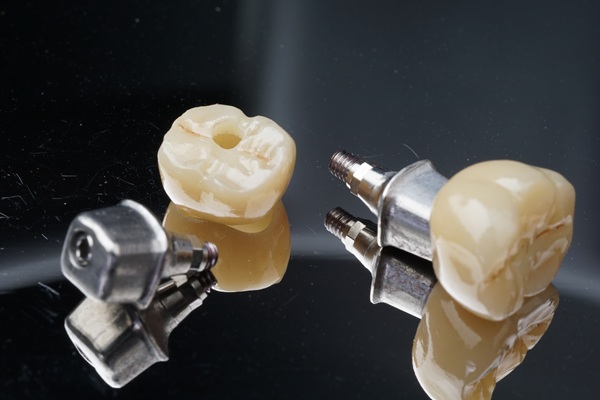What Materials Are Used to Make an Implant Crown?

An implant crown is made of strong and safe materials to give the patient a reliable long-term replacement option for missing teeth. If you have questions about the materials used to make an implant crown, this review can help you understand what exactly each component is made of and why dentists use these particular materials.
Reviewing the implant crown materials and process
There are three primary components of an implant crown restoration for tooth loss: placing the dental implant, installing the abutment, and cementing the crown itself. Each component plays an integral part in the restoration process. They are made of the most appropriate materials to provide a durable and attractive replacement for those missing teeth.
The dental implant
The dental implant is a titanium post that is fixed in the jaw above or below the missing tooth. The reason dentists use titanium for implant restoration is that it can osseointegrate with the jawbone. This means the implant can fuse with the natural bone inside the jaw for a reliable and strong hold for the long term.
The abutment
The dental abutment is typically made of metal. Its role is to serve as a connector between the dental implant and the dental crown. The abutment is not visible and is completely covered by the dental crown. Without it, the crown would not have as secure a hold. With abutments, implant crowns commonly last for more than 15 years.
The dental crown
A common type of dental crown used for dental implant restorations is zirconia crowns. These are made of zirconium dioxide, provide ideal durability, and match the shade and appearance of natural teeth. While there may be other material options available for an implant crown, such as porcelain or metal, zirconia is often recommended.
How the treatment process works
The treatment process for an implant crown is different for every patient. That said, it typically includes a minor surgical procedure where the dentist makes an incision into the gums, drills a tiny hole in the jawbone, and positions the titanium dental implant. The mouth will need time to heal afterward. The abutment and dental crown can be placed on the same follow-up procedure, about four to eight months after the implant placement.
When an implant crown is recommended
Implant crowns are ideal for patients who have a single missing tooth and want the most long-term and natural-looking replacement option. However, an implant partial denture (bridge) or implant-supported completed denture may be a better solution for replacing multiple teeth in a row or on an entire arch.
Discuss implant crown treatment with our team today
You can learn more about implant crowns and the materials used for these restorations by contacting our dental team and scheduling a friendly consultation. We can answer any questions that you may have, and we can put together an implant crown treatment plan that works for you, your preferences, and your schedule. Call our Albany to learn more about our services.
Request an appointment here: http://www.albanydentalcare.net or call Albany Dental Care at (765) 780-2078 for an appointment in our Albany office.
Check out what others are saying about our services on Yelp: Implant Crown in Albany, IN.
Related Posts
Losing a tooth can impact both how your mouth functions and how your smile looks, making it important to find the right replacement. Dental implants are the preferred tooth replacement due to their natural look and feel. Offered by general, family, and cosmetic dentists, implants support long-term oral health and help patients feel more confident…
Implant restoration is a transformative dental procedure that restores function, aesthetics, and confidence by replacing missing teeth with durable, natural-looking implants. While the results are long-lasting, understanding the recovery process and proper aftercare is essential to ensure the success of the implant restoration and maintain optimal oral health.After the placement of an implant restoration, patients…
Many times, a dental practice will recommend avoiding smoking because of the negative effect on the teeth. Smoking can lead to many dental issues. Having a healthy smile is critical, but smoking can reduce the patient’s ability to do so. Keep reading to learn more about tobacco and the teeth.Tobacco and smoking can stain the…
Tooth decay is one of the main dental problems that a dental practice targets. Enamel erosion strips teeth of that protective coating. This results in the formation of cavities. As bacteria proliferate, infection worsens and reaches the dentin, nerves, gums, and jawbones. With proper discipline and the following tips from a good dental practice, anyone…
